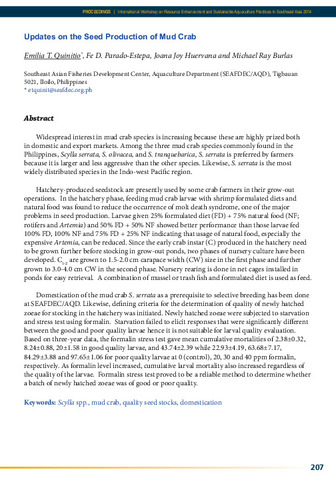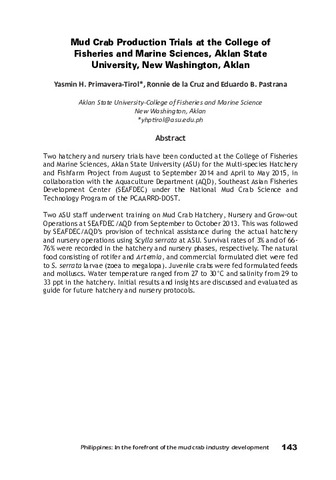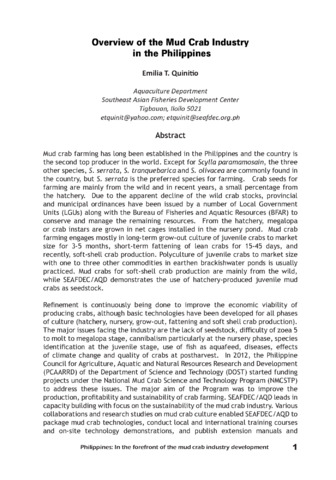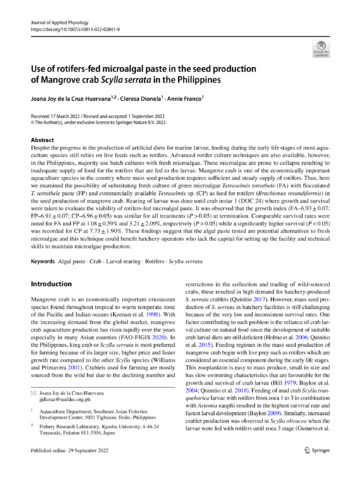Updates on the seed production of mud crab
- Global styles
- MLA
- Vancouver
- Elsevier - Harvard
- APA
- Help

Date
2015Page views
8,691ASFA keyword
AGROVOC keyword
Taxonomic term
Metadata
Show full item record
Share
Abstract
Widespread interest in mud crab species is increasing because these are highly prized both in domestic and export markets. Among the three mud crab species commonly found in the Philippines, Scylla serrata, S. olivacea, and S. tranquebarica, S. serrata is preferred by farmers because it is larger and less aggressive than the other species. Likewise, S. serrata is the most widely distributed species in the Indo-west Pacific region.
Hatchery-produced seedstock are presently used by some crab farmers in their grow-out operations. In the hatchery phase, feeding mud crab larvae with shrimp formulated diets and natural food was found to reduce the occurrence of molt death syndrome, one of the major problems in seed production. Larvae given 25% formulated diet (FD) + 75% natural food (NF; rotifers and Artemia) and 50% FD + 50% NF showed better performance than those larvae fed 100% FD, 100% NF and 75% FD + 25% NF indicating that usage of natural food, especially the expensive Artemia, can be reduced. Since the early crab instar (C) produced in the hatchery need to be grown further before stocking in grow-out ponds, two phases of nursery culture have been developed. C1-2 are grown to 1.5-2.0 cm carapace width (CW) size in the first phase and further grown to 3.0-4.0 cm CW in the second phase. Nursery rearing is done in net cages installed in ponds for easy retrieval. A combination of mussel or trash fish and formulated diet is used as feed.
Domestication of the mud crab S. serrata as a prerequisite to selective breeding has been done at SEAFDEC/AQD. Likewise, defining criteria for the determination of quality of newly hatched zoeae for stocking in the hatchery was initiated. Newly hatched zoeae were subjected to starvation and stress test using formalin. Starvation failed to elicit responses that were significantly different between the good and poor quality larvae hence it is not suitable for larval quality evaluation. Based on three-year data, the formalin stress test gave mean cumulative mortalities of 2.38±0.32, 8.24±0.88, 20±1.58 in good quality larvae, and 43.74±2.39 while 22.93±4.19, 63.68±7.17, 84.29±3.88 and 97.65±1.06 for poor quality larvae at 0 (control), 20, 30 and 40 ppm formalin, respectively. As formalin level increased, cumulative larval mortality also increased regardless of the quality of the larvae. Formalin stress test proved to be a reliable method to determine whether a batch of newly hatched zoeae was of good or poor quality.
Suggested Citation
Quinitio, E. T., Parado-Estepa, F. D., Huervana, J. J., & Burlas, M. R. (2015). Updates on the seed production of mud crab. In M. R. R. Romana-Eguia, F. D. Parado-Estepa, N. D. Salayo, & M. J. H. Lebata-Ramos (Eds.), Resource Enhancement and Sustainable Aquaculture Practices in Southeast Asia: Challenges in Responsible Production of Aquatic Species: Proceedings of the International Workshop on Resource Enhancement and Sustainable Aquaculture Practices in Southeast Asia 2014 (RESA) (pp. 207-212). Tigbauan, Iloilo, Philippines: Aquaculture Dept., Southeast Asian Fisheries Development Center.
Type
Conference paperISBN
9789719931041
Related items
Showing items related by title, author, creator and subject.
-
Mud crab production trials at the College of Fisheries and Marine Sciences, Aklan State University, New Washington, Aklan
Primavera-Tirol, Yasmin H.; de la Cruz, Ronnie; Pastrana, Eduardo B. (Aquaculture Department, Southeast Asian Fisheries Development Center, 2017)Two hatchery and nursery trials have been conducted at the College of Fisheries and Marine Sciences, Aklan State University (ASU) for the Multi-species Hatchery and Fishfarm Project from August to September 2014 and April ... -
Overview of the mud crab industry in the Philippines
Mud crab farming has long been established in the Philippines and the country is the second top producer in the world. Except for Scylla paramamosain, the three other species, S. serrata, S. tranquebarica and S. olivacea ... -
Use of rotifers-fed microalgal paste in the seed production of mangrove crab Scylla serrata in the Philippines
Despite the progress in the production of artificial diets for marine larvae, feeding during the early life stages of most aquaculture species still relies on live feeds such as rotifers. Advanced rotifer culture techniques ...







